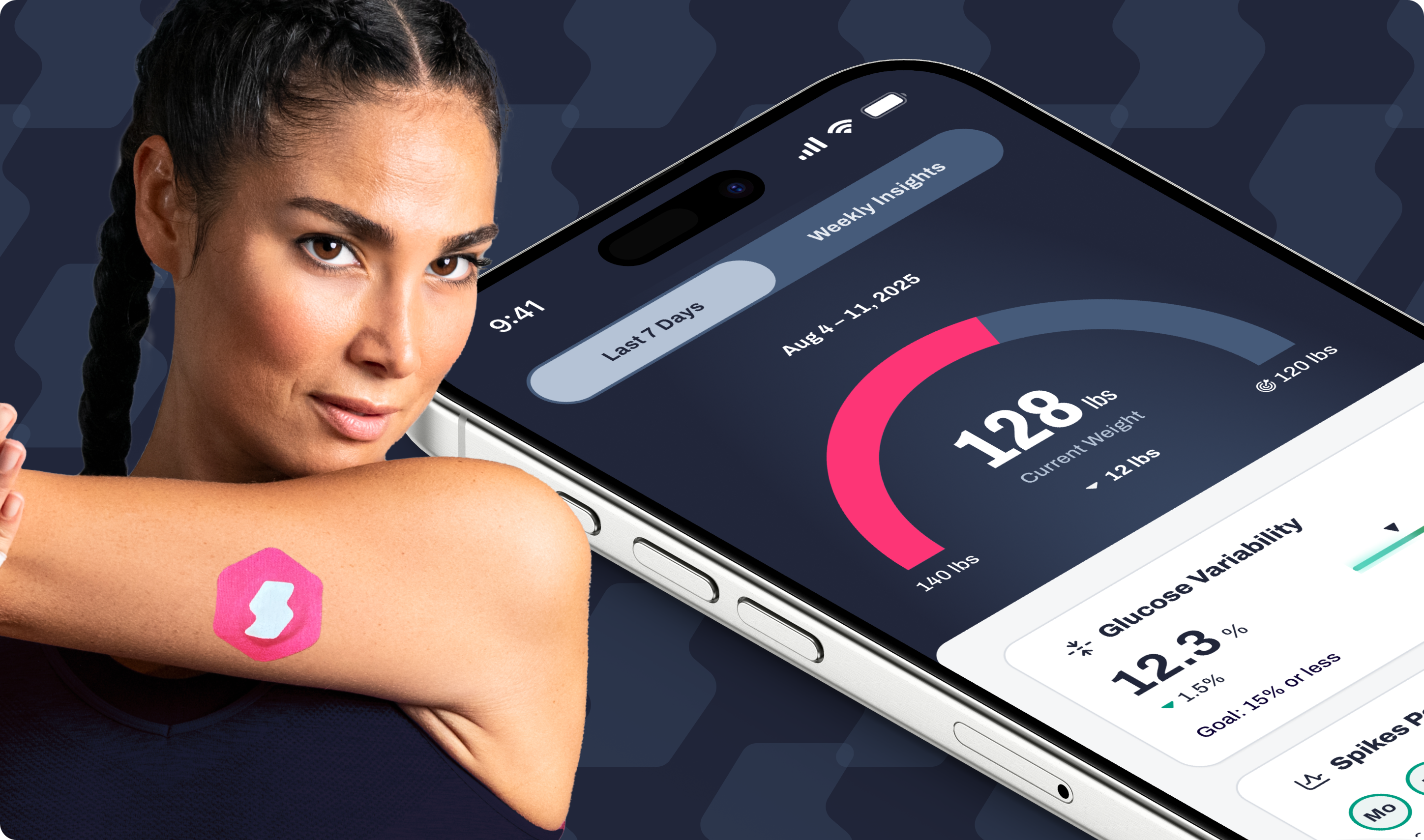Key Takeaways
- Fall hiking naturally provides the perfect environment to achieve Zone 2 cardio, maximizing fat oxidation and building aerobic endurance without the metabolic stress of high-intensity workouts.
- The varied terrain and cool fall air help you effortlessly sustain the conversational pace required for sustaining Zone 2, which is a more enjoyable and effective way to promote long-term insulin sensitivity and metabolic stability.
- Using a continuous glucose monitor provides real-time feedback on how your hiking pace and duration impact your blood sugar stability, allowing you to personalize your routine for actual metabolic improvement.
that {{mid-cta}}
After the decision fatigue of whether to exercise outdoors or indoors in the raging summer heat, rest assured that the best cardio season is just beginning. The crisp fall mornings and moderate daytime temperatures provide the ideal environment for an outdoor, nature-based workout. As the leaves burst into vibrant reds and golds, enjoy the beauty of Mother Nature while pushing your cardiovascular limits and supporting your metabolic health and blood sugar stability.
It’s time to step outside for a hike to reduce the sugar spikes. This article explores why the moderate intensity and unique environmental factors of autumn hikes make them an exceptional outlet for those seeking optimal fitness and metabolic well-being, turning every trail into a path toward better health.
What Is Zone 2 Cardio?

Zone 2 cardio is a moderate-intensity exercise level defined as maintaining a heart rate between 60–70% of your maximum heart rate. If you’re not tracking your heart rate, think of Zone 2 as comfortably challenging: able to hold a conversation but not sing a song. Research tends to find Zone 2 as the 'sweet spot' where your body maximizes burning fat for fuel while still using glucose efficiently.1 In addition, mixing Zone 2 cardio exercise with other higher-intensity training is found to be more effective in improving overall fitness than just Zone 2 cardio alone.2
An article by Peter Attia states that Zone 2 cardio can be highly beneficial for improving mitochondrial function and insulin sensitivity, potentially reversing prediabetes.3 Classic examples of Zone 2 cardio (although this heavily depends on individual factors and fitness levels) include brisk walking, a leisurely hike, an easy bike ride, or a fast-paced yoga class.
Why Hiking Is the Perfect Zone 2 Workout

Hiking a trail can be the perfect way to hit that metabolic sweet spot of Zone 2 cardio. Unlike the steady, sometimes boring pace of a treadmill, the natural pace of a hike, with occasional inclines and slowing to navigate roots and steps, settles your heart rate into the desired zone throughout the journey. If you choose a trail with varied terrain, you can ensure you're building endurance and increasing core and lower leg muscle activation, amplifying the opportunity to burn fat and excess sugar in the bloodstream during one workout.
It’s easy to say that choosing to exercise in Mother Nature’s playground during a cool time of year offers a full-body workout, an opportunity to meditate, and an enjoyable experience, all while you’re improving your metabolic health and wellbeing.
Metabolic Benefits of Zone 2 Hiking

For those focused on optimizing their health and seeing their blood sugar levels drop on their CGM, find a path near you and experience all the benefits Zone 2 hiking can offer.
- Improved glucose control and insulin sensitivity: Moderate intensity exercise helps your muscles efficiently absorb glucose from the bloodstream while increasing their capacity to store it for later use.4
- Enhanced mitochondrial efficiency: Consistent Zone 2 exercise builds stronger, more efficient mitochondria, increasing aerobic capacity and long-term insulin sensitivity.3
- Aids in fat loss and weight management: Training in this heart rate zone has been found to target your body’s ability to use stored fat as its primary fuel source.5
- Stress reduction and better recovery: The calming effect of being in nature, combined with moderate-intensity activity, means less cortisol release both during and after, which can contribute to faster recovery and less muscle and metabolic strain.6
How to Know You’re in Zone 2 While Hiking

Knowing you should be in Zone 2 is one thing, but how can you make sure you’re actually in it? Whether you rely on tech or are able to listen to your body’s cues, here are the best ways to ensure your fall hike is truly optimizing your metabolic health:
- The “Talk Test”: If you can speak in complete sentences but are slightly breathless and couldn't comfortably belt out your favorite song, then you are likely exercising in Zone 2.7
- Heart Rate Monitoring: Smartwatches or chest straps can provide direct, real-time feedback. Aim for 60–70% of your estimated maximum heart rate to ensure you are in Zone 2.
- Using Perceived Exertion Scales: If you don't use a monitor, try the Rate of Perceived Exertion (RPE) scale, where Zone 2 falls between an RPE of 3 to 4, feeling "light-to-somewhat-hard."
The Metabolic Playbook: Structuring a Zone 2 Fall Hike

To increase the metabolic benefits of your fall hike, structure your excursion with a bit of strategy. Start with a 5-10 minute warm-up by walking on a gentle incline or doing dynamic stretches in the parking lot. The core of your hike should be a Zone 2, steady-state effort sustained for approximately 45–90 minutes. This duration allows your body to fully transition into mainly fat oxidation.
Make sure to cool down at the end of your hike with a 5-minute period of easy walking, followed by light stretching and hydration with electrolytes to replenish lost fluids and minerals. Remember to refuel post-hike with a carbohydrate and protein-rich snack to support muscle repair and recovery, helping stabilize blood sugar after your successful cardio workout.
Sample Fall Hiking Plan
Check out these plans designed to help you maintain a Zone 2 heart rate, whether you're new to hiking or an experienced hiker. Remember that breaks are still important, especially for ensuring you stay in that moderate-intensity effort throughout.
- Beginner: Start with a goal hiking time of 30-45 minutes, choosing a flat, smooth trail that has minimal elevation change.
- Intermediate: Bump up the duration of your effort to hit 60-75 minutes on a path that offers rolling hills and mixed terrain.
- Advanced: The sky is the limit: see if you can find a constant Zone 2 heart rate over a duration of 90 minutes, even while encountering harder elevation profiles and terrain.
Using Signos to Personalize Zone 2 Hiking

Integrating a device like a Continuous Glucose Monitor (CGM) takes the guesswork out of optimizing your Zone 2 hiking routine for metabolic health. You can access real-time glucose monitoring that immediately confirms that your moderate, steady-state hike is using stored fuel without causing unnecessary blood sugar spikes or dips.
This immediate feedback instantly personalizes your route and intensity, letting you see precisely how varied terrain, changes in pace, and the overall duration of your hike impact your glucose levels. By consistently logging your activities and nutrition over time, you can track long-term trends of how a routine that includes Zone 2 fall hiking changes your massive peaks and valleys into stable metabolic patterns and insulin sensitivity.
The Bottom Line
This fall season, try trading the gym for a hike on the trails that offer powerful metabolic results without the stress of excessive high-intensity exercise. You don't need fancy gym equipment or an expensive membership, just time with Mother Nature in the cool, crisp fall weather. By pairing this activity with a CGM like Signos, you can measure exactly how every beautiful hike fuels better glucose control and feeling stronger every day. So lace up those hiking boots, hit the fall trails, and find the path to better metabolic health today.
Learn More About Signos’ Expert Advice
If you have more questions on improving your health, fitness, and nutrition, seek the expert advice of the Signos continuous glucose monitor and the Signos team. A continuous glucose monitor (CGM) can give you the insights to make smarter nutrition and exercise choices. The Signos app provides a unique, personalized program to help you reach your health goals.
Topics discussed in this article:
References
- Carey, D. G. (2009). Quantifying differences in the “fat burning” zone and the aerobic zone: implications for training. The Journal of Strength & Conditioning Research, 23(7), 2090-2095.
- Storoschuk, K. L., Moran-MacDonald, A., Gibala, M. J., & Gurd, B. J. (2025). Much Ado About Zone 2: A Narrative Review Assessing the Efficacy of Zone 2 Training for Improving Mitochondrial Capacity and Cardiorespiratory Fitness in the General Population: KL Storoschuk et al. Sports Medicine, 1-14.
- Attia, P. A guide to Zone 2 training: its profound impact on health, detailed training instructions, addressing male and female differences, and more.
- Ryan, B. J., Schleh, M. W., Ahn, C., Ludzki, A. C., Gillen, J. B., Varshney, P., ... & Horowitz, J. F. (2020). Moderate-intensity exercise and high-intensity interval training affect insulin sensitivity similarly in obese adults. The Journal of Clinical Endocrinology & Metabolism, 105(8), e2941-e2959.
- San-Millán I. (2023). The Key Role of Mitochondrial Function in Health and Disease. Antioxidants (Basel, Switzerland), 12(4), 782. https://doi.org/10.3390/antiox12040782
- Torres, R., Koutakis, P., & Forsse, J. (2021). The effects of different exercise intensities and modalities on cortisol production in healthy individuals: a review. Journal of Exercise and Nutrition, 4(4).
- Woltmann, M. L., Foster, C., Porcari, J. P., Camic, C. L., Dodge, C., Haible, S., & Mikat, R. P. (2015). Evidence that the talk test can be used to regulate exercise intensity. The Journal of Strength & Conditioning Research, 29(5), 1248-1254.




.svg)










.svg)
.svg)
.svg)
.svg)
.svg)
.svg)
.svg)
